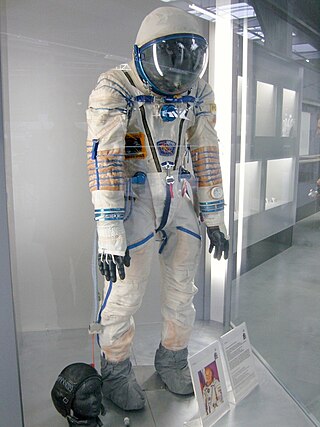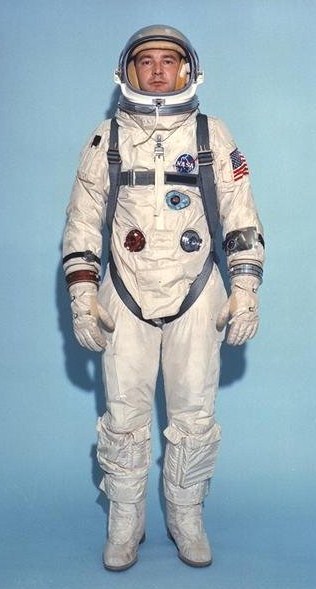
Extravehicular activity (EVA) is any activity done by an astronaut in outer space outside a spacecraft. In the absence of a breathable Earthlike atmosphere, the astronaut is completely reliant on a space suit for environmental support. EVA includes spacewalks and lunar or planetary surface exploration. In a stand-up EVA (SEVA), an astronaut stands through an open hatch but does not fully leave the spacecraft. EVAs have been conducted by the Soviet Union/Russia, the United States, Canada, the European Space Agency and China.

A space suit or spacesuit is a garment worn to keep a human alive in the harsh environment of outer space, vacuum and temperature extremes. Space suits are often worn inside spacecraft as a safety precaution in case of loss of cabin pressure, and are necessary for extravehicular activity (EVA), work done outside spacecraft. Space suits have been worn for such work in Earth orbit, on the surface of the Moon, and en route back to Earth from the Moon. Modern space suits augment the basic pressure garment with a complex system of equipment and environmental systems designed to keep the wearer comfortable, and to minimize the effort required to bend the limbs, resisting a soft pressure garment's natural tendency to stiffen against the vacuum. A self-contained oxygen supply and environmental control system is frequently employed to allow complete freedom of movement, independent of the spacecraft.

A rebreather is a breathing apparatus that absorbs the carbon dioxide of a user's exhaled breath to permit the rebreathing (recycling) of the substantially unused oxygen content, and unused inert content when present, of each breath. Oxygen is added to replenish the amount metabolised by the user. This differs from open-circuit breathing apparatus, where the exhaled gas is discharged directly into the environment. The purpose is to extend the breathing endurance of a limited gas supply, and, for covert military use by frogmen or observation of underwater life, eliminating the bubbles produced by an open circuit system and in turn not scaring wildlife being filmed. A rebreather is generally understood to be a portable unit carried by the user. The same technology on a vehicle or non-mobile installation is more likely to be referred to as a life-support system.

The Extravehicular Mobility Unit (EMU) is an independent anthropomorphic spacesuit that provides environmental protection, mobility, life support, and communications for astronauts performing extravehicular activity (EVA) in Earth orbit. Introduced in 1981, it is a two-piece semi-rigid suit, and is currently one of two types of EVA spacesuits used by crew members on the International Space Station (ISS), the other being the Russian Orlan space suit. It was used by NASA's Space Shuttle astronauts prior to the end of the Shuttle program in 2011.

A life-support system is the combination of equipment that allows survival in an environment or situation that would not support that life in its absence. It is generally applied to systems supporting human life in situations where the outside environment is hostile, such as outer space or underwater, or medical situations where the health of the person is compromised to the extent that the risk of death would be high without the function of the equipment.

The Quest Joint Airlock, previously known as the Joint Airlock Module, is the primary airlock for the International Space Station. Quest was designed to host spacewalks with both Extravehicular Mobility Unit (EMU) spacesuits and Orlan space suits. The airlock was launched on STS-104 on July 14, 2001.

A space capsule is a spacecraft designed to transport cargo, scientific experiments, and/or astronauts to and from space. Capsules are distinguished from other spacecraft by the ability to survive reentry and return a payload to the Earth's surface from orbit or sub-orbit, and are distinguished from other types of recoverable spacecraft by their blunt shape, not having wings and often containing little fuel other than what is necessary for a safe return. Capsule-based crewed spacecraft such as Soyuz or Orion are often supported by a service or adapter module, and sometimes augmented with an extra module for extended space operations. Capsules make up the majority of crewed spacecraft designs, although one crewed spaceplane, the Space Shuttle, has flown in orbit.

ILC Dover, LP is a special engineering development and manufacturing company, globally headquartered in Frederica, Delaware. ILC Dover specializes in the use of high-performance flexible materials, serving the aerospace, personal protection, and pharmaceutical industries.

The Apollo/Skylab space suit is a class of space suits used in Apollo and Skylab missions. The names for both the Apollo and Skylab space suits were Extravehicular Mobility Unit (EMU). The Apollo EMUs consisted of a Pressure Suit Assembly (PSA) aka "suit" and a Portable Life Support System (PLSS) that was more commonly called the "backpack". The A7L was the PSA model used on the Apollo 7 through 14 missions.

The Sokol space suit is a series of soft-body pressure suits designed and built by NPP Zvezda. It was first introduced in 1973 for the Soviet space program following the Soyuz 11 disaster, and continues to see use in the modern day primarily by the Russian space program, being worn by space travelers flying aboard the Soyuz spacecraft. A version of Sokol is also used by the China Manned Space Program.

The Advanced Crew Escape Suit (ACES), or "pumpkin suit", is a full pressure suit that Space Shuttle crews began wearing after STS-65, for the ascent and entry portions of flight. The suit is a direct descendant of the U.S. Air Force high-altitude pressure suits worn by the two-man crews of the SR-71 Blackbird, pilots of the U-2 and X-15, and Gemini pilot-astronauts, and the Launch Entry Suits (LES) worn by NASA astronauts starting on the STS-26 flight, the first flight after the Challenger disaster. The suit is manufactured by the David Clark Company of Worcester, Massachusetts. Cosmetically the suit is very similar to the LES. ACES was first used in 1994.

The Gemini spacesuit is a spacesuit worn by American astronauts for launch, in-flight activities and landing. It was designed by NASA based on the X-15 high-altitude pressure suit. All Gemini spacesuits were developed and manufactured by the David Clark Company in Worcester, Massachusetts.

Beta cloth is a type of fireproof PTFE impregnated silica fiber cloth used in the manufacture of Apollo/Skylab A7L space suits, the Apollo Thermal Micrometeoroid Garment, the McDivitt Purse, and in other specialized applications.

A primarylife support system (PLSS), is a device connected to an astronaut or cosmonaut's spacesuit, which allows extra-vehicular activity with maximum freedom, independent of a spacecraft's life support system. A PLSS is generally worn like a backpack. The functions performed by the PLSS include:

The Constellation Space Suit was a planned full pressure suit system that would have served as an intra-vehicular activity (IVA) and extra-vehicular activity (EVA) garment for the proposed Project Constellation flights. The design of the suit was announced by NASA on June 11, 2008, and it was to be manufactured by Houston, Texas-based Oceaneering International, the 4th company after the David Clark Company, Hamilton Sundstrand, and ILC Dover to produce life-support hardware, as a prime contractor, for in-flight space use.

Space architecture is the theory and practice of designing and building inhabited environments in outer space. This mission statement for space architecture was developed at the World Space Congress in Houston in 2002 by members of the Technical Aerospace Architecture Subcommittee of the American Institute of Aeronautics and Astronautics (AIAA). The architectural approach to spacecraft design addresses the total built environment. It is mainly based on the field of engineering, but also involves diverse disciplines such as physiology, psychology, and sociology.

The International Space Station Environmental Control and Life Support System (ECLSS) is a life support system that provides or controls atmospheric pressure, fire detection and suppression, oxygen levels, waste management and water supply. The highest priority for the ECLSS is the ISS atmosphere, but the system also collects, processes, and stores both waste and water produced and used by the crew—a process that recycles fluid from the sink, shower, toilet, and condensation from the air.

The Launch Entry Suit (LES), known as the "pumpkin suit", is a partial-pressure suit that was worn by all Space Shuttle crews for the ascent and entry portions of flight from STS-26 (1988) to STS-65 (1994). It was completely phased out by STS-88 and replaced by the ACES suit. The suit was manufactured by the David Clark Company of Worcester, Massachusetts.

A single-person spacecraft is a vehicle designed for space travel. The concept has been used in science fiction and actual ships such as the Mercury capsule, Vostok and some suborbital designs. Single-person spacecraft have been envisioned as a supplement or replacement for space suits in certain applications. The Von Braun Bottle suit of the 1950s functions as a hybrid of a space suit and a one-person spacecraft.

A Mars suit or Mars space suit is a space suit for EVAs on the planet Mars. Compared to a suit designed for space-walking in the near vacuum of low Earth orbit, Mars suits have a greater focus on actual walking and a need for abrasion resistance. Mars' surface gravity is 37.8% of Earth's, approximately 2.3 times that of the Moon, so weight is a significant concern, but there are fewer thermal demands compared to open space. At the surface the suits would contend with the atmosphere of Mars, which has a pressure of about 0.6 to 1 kilopascal. On the surface, radiation exposure is a concern, especially solar flare events, which can dramatically increase the amount of radiation over a short time.




















